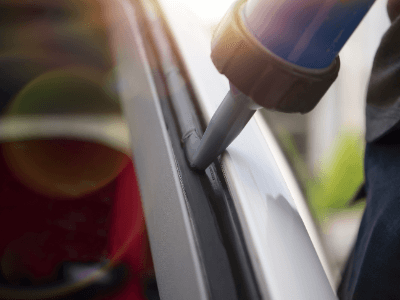What Is a Sealant?

A Sealant is a material used to fill joints and gaps to prevent water and air from entering.
Sealants are also used to fill gaps in buildings and structures to provide cushioning and prevent damage to building materials. Sealants are flexible and maintain a certain degree of elasticity even after drying, allowing them to accommodate the movement of materials. They do not hold materials firmly together like an adhesive, but their main purpose is to fill gaps.
Sealant is also a term used in the field of dentistry. It refers to a highly effective method of cavity prevention that uses a plastic resin to fill gaps between back teeth.
Uses of Sealants
Sealants are used to fill in the joints of buildings and structures to make them watertight, confidential, cushioned, or anchored. Specific applications are as follows:
1. Gaps Between Windows and Doors of Houses
Sealants can be used in the gaps between windows and doors of houses to prevent water and wind from entering, and to improve thermal and sound insulation.
2. Joints in Bathrooms and Kitchens
Sealants can be used in bathroom and kitchen joints to prevent water and dirt from penetrating and to inhibit the formation of mold and blackening.
3. Cracks in Outdoor Roofs and Walls
Sealants can be used on cracks in outdoor roofs and walls to prevent rainwater intrusion and building deterioration.
4. Gaps in Automobile Windows and Sunroofs
Sealants can be used to seal gaps in automobile windows and sunroofs to prevent water and wind from entering and to maintain a comfortable interior environment.
Principles of Sealants
Sealants work primarily on the following principles:
1. Fill Gaps
Sealants fill gaps to prevent water and air from penetrating. The flexibility of the sealant also allows the material to move and fill the gap.
Since the sealant is in liquid form before curing, it can be sealed even if the bonding surface is uneven. It also absorbs tolerance variations such as joints.
2. Adhesion
Sealant has the ability to adhere to materials. This prevents the sealant from floating out of the gap. Furthermore, since it also has adhesive strength, it can be expected to prevent bolts from loosening.
3. Weather Resistance
Sealant is resistant to ultraviolet rays and temperature changes. This makes the sealant resistant to deterioration and allows it to continue working to fill gaps over a long period of time.
Types of Sealants
There are many different types of sealants. Each sealant is used for different purposes, depending on the characteristics of the sealant. The following is an overview of typical sealants:
1. Silicone Sealants
Silicone sealants are mainly composed of silicone resin, which has high water and weather resistance and is suitable for many materials. In particular, they are often used for joints in bathrooms and kitchens, and for cracks in roofs and walls. Silicone sealants are also highly elastic and can handle the opening of gaps caused by material movement.
2. Acrylic Sealants
Acrylic sealants are made primarily of acrylic resin and are less expensive than silicone sealants. They are considered safe to use since they are water-based. They have a disadvantage of significant volume shrinkage as the water evaporates and the sealant hardens after application. It is often used for gaps between windows and doors of houses and for cracks in interior walls.
3. Urethane Sealants
Urethane sealants are mainly composed of urethane resin and have strong adhesive strength and elasticity. They also have excellent abrasion resistance and oil resistance. As a result, they are often used for gaps between parts of automobiles and ships. However, their low resistance to ultraviolet rays requires caution when used outdoors.
Other Information on Sealants
1. Precautions for Using Sealants
If sealants are not applied in the proper amount, product failure or other hazards can occur due to the following reasons:
- If Too Much Is Applied
Sealant may penetrate into the interior of the product and become a foreign substance. - If Too Little Is Applied
The sealant may be insufficient to maintain confidentiality.
2. Application Method
Sealant can be applied to both sides of the sealant surface or only to one side. The following are points to be considered:
- When Applying to Both Sides
In order to apply the sealant before it cures, it is necessary to apply the appropriate amount of sealant. - When Applying to One Side
The surface to which sealant is not applied should be even, as it must be cured before assembly.